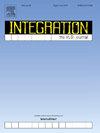带有中介系统的主从构型无人机球面混沌轨迹跟踪与形成
IF 2.5
3区 工程技术
Q3 COMPUTER SCIENCE, HARDWARE & ARCHITECTURE
引用次数: 0
摘要
该方案解决了利用四轴飞行器跟踪球面混沌轨迹的问题。后步控制用于稳定和单独控制四轴飞行器。随后,采用主从结构,采用动态耦合作为中间系统,配合步进控制,实现四轴飞行器的同步和编队。此外,还进行了防碰撞计算,以避免四轴飞行器之间可能发生的碰撞。采用带有混沌吸引子的混合动力系统生成待跟踪的混沌轨迹,混沌吸引子生成伪随机值,允许创建球形混沌轨迹。在MATLAB和Julia中实现了所提出的控制、耦合和轨迹跟踪方案。实验结果表明,四轴飞行器实现了所提球面混沌轨迹的同步和形成。本文章由计算机程序翻译,如有差异,请以英文原文为准。

Spherical chaotic trajectory tracking and formation of unmanned aerial vehicles in master–slave configuration with intermediary system
This proposal addresses the problem of tracking spherical chaotic trajectories using quadcopters. The backstepping control is used to stabilizes and individually controls the quadcopters. Subsequently, using a master–slave configuration, dynamic coupling is used as an intermediary system in conjunction with backstepping control in order to achieve synchronization and formation of quadcopters. In addition, an anti-collision calculation is implemented to avoid possible collisions between the quadcopters. The chaotic trajectory to be followed is generated using a hybrid dynamic system with a chaotic attractor, which generates pseudo-random values allowing the creation of chaotic trajectories of sphere type. The proposed control, coupling and trajectory tracking schemes are implemented in MATLAB and Julia. Experiments are implemented where the results show that the quadcopters achieve synchronization and formation of the proposed spherical chaotic trajectories.
求助全文
通过发布文献求助,成功后即可免费获取论文全文。
去求助
来源期刊

Integration-The Vlsi Journal
工程技术-工程:电子与电气
CiteScore
3.80
自引率
5.30%
发文量
107
审稿时长
6 months
期刊介绍:
Integration''s aim is to cover every aspect of the VLSI area, with an emphasis on cross-fertilization between various fields of science, and the design, verification, test and applications of integrated circuits and systems, as well as closely related topics in process and device technologies. Individual issues will feature peer-reviewed tutorials and articles as well as reviews of recent publications. The intended coverage of the journal can be assessed by examining the following (non-exclusive) list of topics:
Specification methods and languages; Analog/Digital Integrated Circuits and Systems; VLSI architectures; Algorithms, methods and tools for modeling, simulation, synthesis and verification of integrated circuits and systems of any complexity; Embedded systems; High-level synthesis for VLSI systems; Logic synthesis and finite automata; Testing, design-for-test and test generation algorithms; Physical design; Formal verification; Algorithms implemented in VLSI systems; Systems engineering; Heterogeneous systems.
 求助内容:
求助内容: 应助结果提醒方式:
应助结果提醒方式:


